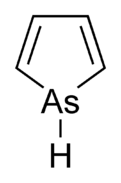Arsole
|
|
|||
| Names | |||
|---|---|---|---|
|
Preferred IUPAC name
Arsole
|
|||
|
Systematic IUPAC name
1H-Arsole
|
|||
| Other names
Arsenole
Arsacyclopentadiene |
|||
| Identifiers | |||
|
287-77-4 |
|||
| 3D model (Jmol) |
Interactive image Interactive image |
||
| ChEBI |
CHEBI:33131 |
||
| ChemSpider |
16787685 |
||
|
|||
|
|||
| Properties | |||
| C4H4AsH | |||
| Molar mass | 128.00 g mol−1 | ||
| Related compounds | |||
|
Related compounds
|
Pyrrole, phosphole, bismole, stibole | ||
|
Except where otherwise noted, data are given for materials in their standard state (at 25 °C [77 °F], 100 kPa).
|
|||
|
|
|||
| Infobox references | |||
Arsole, also called arsenole or arsacyclopentadiene, is an organoarsenic compound with the formula C4H4AsH. It is classified as a metallole and is isoelectronic to and related to pyrrole except that an arsenic atom is substituted for the nitrogen atom. Whereas the pyrrole molecule is planar, the arsole molecule is not, and the hydrogen atom bonded to arsenic extends out of the molecular plane. Arsole is only moderately aromatic, with about 40% the aromaticity of pyrrole. Arsole itself has not been reported in pure form, but several substituted analogs called arsoles exist. Arsoles and more complex arsole derivatives have similar structure and chemical properties to those of phosphole derivatives. When arsole is fused to a benzene ring, this molecule is called arsindole, or benzarsole.
Arsole belongs to the series of heterocyclic pnictogen compounds. The naming of cyclic organoarsenic compounds such as arsole is based on an extension of the Hantzsch–Widman nomenclature system approved by IUPAC, as summarized below:
Because of its similarity to the English slang word "arsehole" (in common use outside North America), the name "arsole" has been considered a target of fun, a "silly name", and one of several chemical compounds with an unusual name. However, this "silly name" coincidence has also stimulated detailed scientific studies.
Arsole itself has not been isolated experimentally yet, but the molecular geometry and electronic configuration of arsole have been studied theoretically. Calculations also addressed properties of simple arsole derivatives, where hydrogen atoms are substituted by other atoms or small hydrocarbon groups, and there are experimental reports on chemical properties of more complex arsole derivatives. The situation is similar for other C4H4MH metalloles where M = P, As, Sb and Bi.
...
Wikipedia


